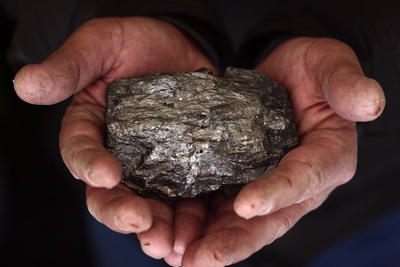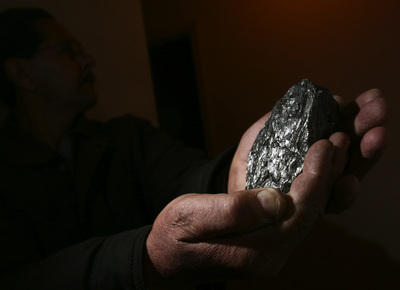
It wasn't exactly pennies from heaven, but if the smoldering, dark-colored rock discovered on Mitch Medeiros' property did indeed fall from the sky, it may fetch the 55-year-old a fortune. If, that is, it's a verifiable meteorite.
Whatever it is has turned life upside down for the retired truck driver.
Medeiros said his phone has continued to ring since he told friends his dog -- an energetic 2-year-old black Labrador retriever named Bella -- led him Wednesday to a small dirt pile that was spewing steam in the backyard of his Castro Valley hills home.
"She was the one who found it. I never would have known," he said.
While Bella barked in excitement, Medeiros shoveled the rock out of a fresh, foot-deep hole. It was glowing "like a barbecue coal," he said.
He ran water to cool the jagged charcoal-colored rock, which is about 2 inches wide and 4 inches long.
He kept it in a cabinet for two days and didn't think much of it until he realized he could not answer a nagging question: Why would a normal rock glow?
"I've never seen one like that before," he said.
Medeiros, a married man with three children, telephoned Lawrence Livermore Laboratory for advice Friday morning.
"We get these kinds of calls maybe a couple of times a month and, more often than not, it turns out not to be a meteor," said Lynda Seaver, a lab spokeswoman.
Experts say that reports of meteorites are frequent, but like any valuable mineral, finding the real deal -- or any object plummeting from the sky -- is rare.
But it's possible, lab scientists told Medeiros. They advised him to chip off a piece of the rock and mail it to the University of New Mexico, where experts will use an electron microscope to determine the rock's properties, Medeiros said.
He since has stored the potentially valuable mineral in a bank safe-deposit box.
In the meantime, he has fielded a torrent of phone calls from aggressive members of a subculture he previously didn't know existed: meteorite collectors and dealers.
"I'm not even sure how they found out I had it," said Medeiros, who grew up in San Leandro.
Rare forms often end up in major museums and have sold for as much as $1,000 per gram -- well above the current price of gold, according to a meteorite-related website.
But he's not biting on any offers yet. It might be just another rock or a small piece of an old Russian spacecraft that has turned to junk in recent years.
On the advice of websites and Lawrence Lab scientists, Medeiros said he has put the rock through a number of tests.
A magnet, for example, did not stick to it and its excessive hardness broke off a hacksaw blade -- both good signs, experts told Medeiros.
"It's almost like cutting stainless steel, it just bounces off," he said.
The rock is so resistant it has made it difficult for him to break off a sample for official testing. But Medeiros is determined to find out and, he adds, he's growing more confident.
"It's passed at least three of the tests," he said. "It's a meteor."




Comment: Meteorites officially cannot be warm or hot when they reach the ground. So much for official science then.